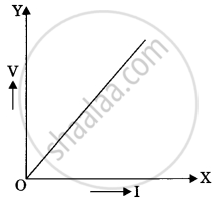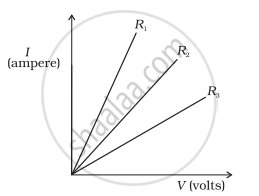Advertisements
Advertisements
Question
How is electric current related to the potential difference across the terminals of a conductor?
Draw a labelled circuit diagram to verify this relationship.
Solution
V = IR, where V is potential difference, I is current and R is constant for a given resistor as its resistance. Hence, current I is directly proportional to V.

APPEARS IN
RELATED QUESTIONS
A low voltage supply from which one needs high currents must have very low internal resistance. Why?
- Draw a V-I graph for a conductor obeying Ohm’s law.
- What does the slope of V–I graph for a conductor represent?
How does an increase in the temperature affect the specific resistance of a :
(i) Metal and
(ii) Semiconductor ?
Define the following:
(i) Coulomb
(ii) Ohm
- Name and state the law which relates the potential difference and current in a conductor.
- What is the necessary condition for a conductor to obey the law named above in part (a) ?
What is non-ohmic resistor?
Explain the equivalent resistance of a series resistor network.
The slope of voltage (V) versus current (I) is called:

A student carries out an experiment and plots the V-I graph of three samples of nichrome wire with resistances R1, R2 and R3 respectively. Which of the following is true?

State Ohm's Law. Represent it mathematically.
